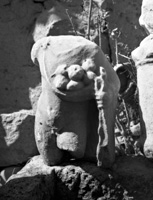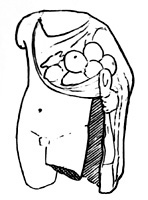 MAMA XI 189 (Synnada)
MAMA XI 189 (Synnada) 
Sculptural fragment of a personification of Autumn
- Type of monument:
- Sculptural fragment, probably from a sarcophagus.
- Location:
- Şuhut (Synnada): in the yard of a mill, with MAMA XI 188 (1955/9).
- Description:
- White marble male figure, nude except for a cloak fastened on the right shoulder and falling down the left side; the left hand supports a fold filled with fruit. Head and right arm missing; both legs broken off above the knees.
- Dimensions:
-
Ht. 0.40+; W. 0.25; Th. 0.19.
- Record:
- MB notebook copy; drawing; photograph (1955/8).
- Publication:
- None.
- Date:
- Roman imperial period.
-
-
 MAMA XI 189 (Synnada)
MAMA XI 189 (Synnada) 





This figure appears to be a personification of the season of Autumn. Given the dimensions of the figure, it seems likely that it derives from a Dokimeian sarcophagus with high figured relief; for a sarcophagus of the Roman imperial period from Aphrodisias with four Erotes symbolising the four seasons, see Erim 1990: 34-6. The four seasons are depicted along with the three graces on a sarcophagus from Ste-Marie-du-Zit in Tunisia, which may be imitating Dokimeian work (Morey 1924: 52-3); the representation of Autumn is very similar to the sculptural fragment from Şuhut.